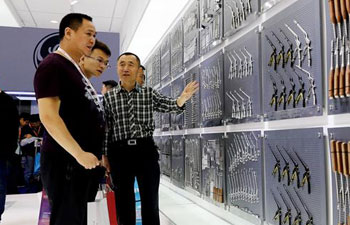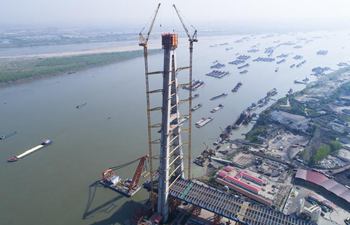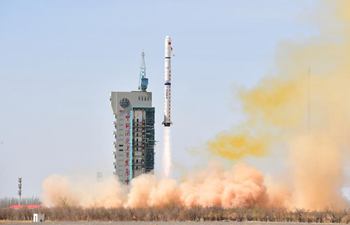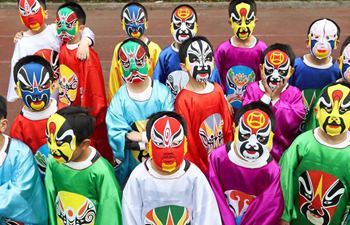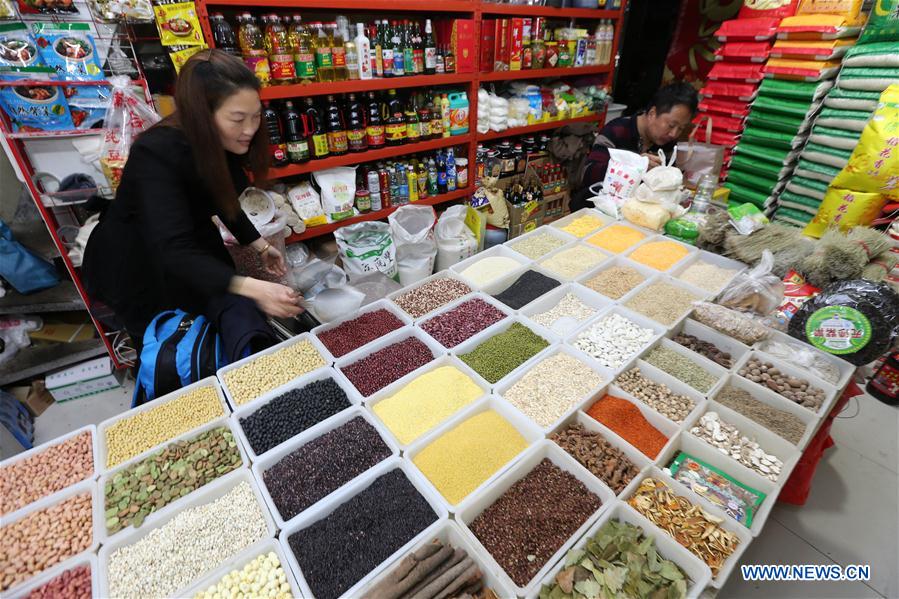
A grocer sells grains at a market in Nantong City of east China's Jiangsu Province, April 11, 2018. China's consumer price index (CPI), a main gauge of inflation, rose 2.1 percent year on year in March, down from 2.9 percent for February, according to data from the National Bureau of Statistics showed Wednesday. (Xinhua/Xu Congjun)
BEIJING, April 11 (Xinhua) -- China registered a mild increase in consumer and producer prices in March, indicating balanced supply and demand in a stabilizing economy.
The consumer price index (CPI), a main gauge of inflation, rose 2.1 percent year on year in March, down from 2.9 percent for February, data from the National Bureau of Statistics (NBS) showed Wednesday.
"Stable prices suggested a healthy economy and also provided a good macro-environment for the economy to grow," the NBS said in a statement.
On a month on month basis, CPI declined 1.1 percent, according to NBS data.
NBS statistician Sheng Guoqing attributed the drop to the ebb of holiday factors, which pushed up demand in February.
Food prices went down 4.2 percent compared with February, contributing 0.86 percentage points to the month-on-month decline in CPI.
As travel demand faded after the Spring Festival, prices of air tickets, travel agency charges, and long-distance bus tickets dropped 18.7 percent, 11.7 percent, and 4.7 percent respectively, compared with February.
In the first quarter, CPI rose at a "generally stable" rate of 2.1 percent despite fluctuations, NBS said.
Non-food prices maintained stable growth of 2.2 percent in the first three months, a relatively fast rate that indicated an upgrade in consumption, according to an NBS statement.
"As people's standards of living improve, the demand for service-related consumption has been on the rise, leading to an increase in service prices," NBS said.
China expects CPI to increase by around 3 percent in 2018, according to a government work report released in March.
Mild CPI growth in March proved that high inflation this year is unlikely, said Deng Haiqing, chief economist with brokerage firm JZ Securities.
"Judging from historical experience, the central bank will not resort to policy tightening when CPI growth is no more than 2.5 percent," Deng said.
The producer price index (PPI), which measures costs for goods at the factory gate, rose 3.1 percent year on year in March, down from growth of 3.7 percent in February.
Growth in factory prices of production materials and consumer goods both moderated, according to Sheng.
In the first quarter, PPI rose by 3.7 percent year on year, easing from 5.8-percent growth in the fourth quarter of 2017.
The moderation was normal, considering a high comparison base, NBS said.
The stable increase in PPI was a combined result of improved supply and rising demand, NBS said.
On the supply side, the country's structural reforms, including capacity cuts in some industrial sectors, improved product quality.
In terms of demand, stable economic growth helped both investment and consumption maintain upward momentum.
"The positive changes in supply and demand have created conditions for companies to increase their earnings," NBS said.
Earlier data showed that industrial companies with annual revenue of more than 20 million yuan (about 3.2 million U.S. dollars) saw their combined profits rise 16.1 percent year on year in the first two months.
Looking forward, the NBS said China is able to keep prices at a "generally stable" level in the near term.




